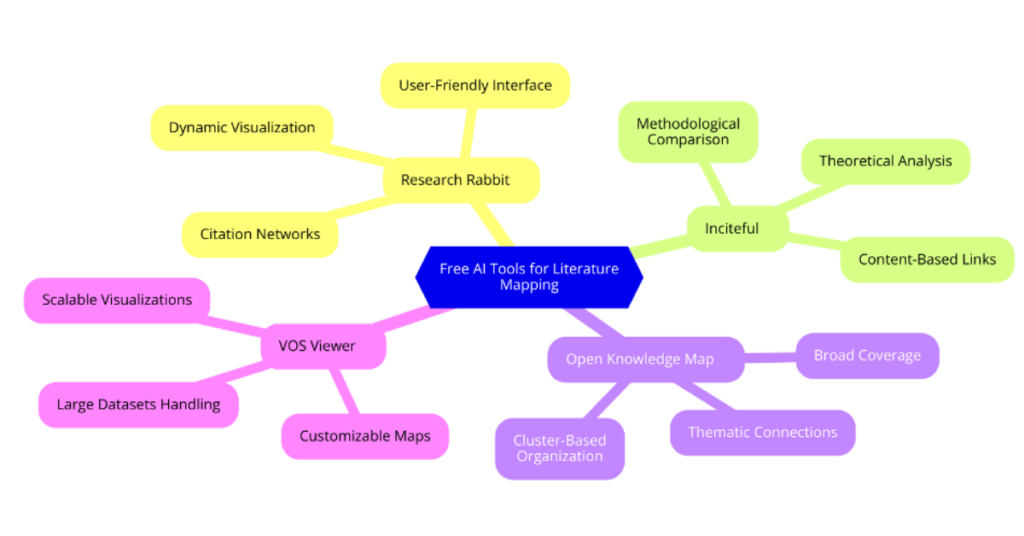
In the realm of academic research, literature mapping is an indispensable technique that enables researchers to navigate vast seas of data and scholarly articles efficiently. With the advent of Artificial Intelligence (AI), the process of literature mapping has been revolutionized, allowing for more precise, faster, and comprehensive exploration of academic materials. This blog delves deep into the concept of literature mapping, the role of AI in enhancing these processes, and a look at some cutting-edge tools that are reshaping research methodologies.
Literature mapping serves as a fundamental aspect of research that helps in the identification of the main contributors, theories, methodologies, and gaps within any given field of study. It’s a strategic approach, often visual, that organizes and presents information in a way that reveals relationships and trends that might not be apparent from a straightforward literature review.
Literature mapping, or bibliometric mapping, involves the graphical representation of the relationships between different research publications or researchers. It uses various metrics like co-authorships, citation links, and co-occurrence of keywords to create visualizations that illustrate how pieces of literature are connected. This method provides a macro-view of the landscape of scholarly publications, offering insights into the development of research areas, prevailing theories, and emerging trends.
The traditional method of conducting literature reviews is notoriously time-consuming. Researchers often spend weeks, if not months, delving through extensive arrays of articles to establish a solid foundational background for their projects. This prolonged process involves not only identifying relevant papers but also understanding their interconnections and overall impact on the field. AI-driven literature mapping tools dramatically streamline this task.
By harnessing the power of AI, these tools can automate the identification and visualization of connections between research studies, swiftly uncovering relationships based on citations, authorships, and thematic similarities. This automation allows researchers to bypass the initial exhaustive search and evaluation phase, directing their focus swiftly towards synthesizing the most pertinent information.
With AI tools, the time spent on the literature review process can be reduced significantly—often by up to 50-70%. This remarkable reduction in time is achieved without sacrificing the depth or breadth of the review. In fact, AI tools typically enhance the review’s thoroughness by covering a wider array of literature than would be possible manually. This includes identifying less obvious, yet potentially influential, works that might escape notice during traditional reviews.
Moreover, AI tools continuously update with new publications, ensuring that literature maps remain relevant and incorporate the latest research. This aspect is crucial in fast-evolving fields where staying updated with the most recent studies can be pivotal to the research’s relevance and success.
In summary, AI tools not only expedite the literature review process but also enrich it, making comprehensive reviews more feasible and far less time-intensive. This efficiency not only accelerates the overall research process but also enables a more dynamic engagement with the evolving academic landscape.
AI tools enhance literature mapping by bringing in advanced algorithms that automate the extraction, analysis, and visualization of data from large sets of documents. Here’s how AI contributes to the efficiency and effectiveness of literature mapping:
In the fast-paced domain of academic research, the ability to efficiently map existing literature is critical. Literature mapping not only aids in understanding the scope of research within a given domain but also highlights the relationships and dynamics between various studies. Thanks to advancements in artificial intelligence (AI), several powerful tools have been developed to assist researchers in creating intricate and informative literature maps. These AI-powered tools leverage cutting-edge technology to simplify and enhance the process, making literature mapping more accessible and insightful. Let’s explore some of the standout AI tools currently transforming literature mapping in academic research.
Research Rabbit
Research Rabbit is an innovative tool that employs a citation-based approach to visualize networks of papers. This tool is instrumental in uncovering how various studies interlink within a specific research area, identifying key papers that serve as nodes in the broader academic dialogue. Research Rabbit’s algorithm sifts through extensive databases to find not only direct citations but also thematic connections, providing a holistic view of the research landscape.
Key Features:
Benefits for Researchers:
Inciteful
Inciteful stands out by not just linking papers based on citations but by analyzing the content to determine how methodologies, findings, and theoretical frameworks align or differ. This depth of analysis is crucial for researchers aiming to understand not only what has been studied but how these studies approach their hypotheses and conclusions.
Key Features:
Benefits for Researchers:
Open Knowledge Map
Open Knowledge Map enhances literature mapping by creating visual knowledge maps that cluster related papers around central themes. This tool is particularly useful for researchers new to a field or those exploring interdisciplinary connections, as it presents an immediate visual breakdown of major topics and their relative research outputs.
Key Features:
Benefits for Researchers:
VOS Viewer
VOS Viewer specializes in constructing detailed bibliometric networks that can be tailored to reflect citations, co-authorship, keywords, and more. This tool is renowned for its ability to handle large datasets, providing precise and scalable visualizations that are essential for comprehensive literature reviews.
Key Features:
Benefits for Researchers:
AI tools for literature mapping are transforming the way academics engage with scholarly materials. Tools like Research Rabbit, Inciteful, Open Knowledge Map, and VOS Viewer enable researchers to conduct thorough and nuanced reviews of literature with an efficiency and depth that were previously unattainable. As these tools continue to evolve, they promise to further empower the academic community, enhancing both the speed and quality of research across all disciplines.

Dr. Chopra is the founder and editor of thephdcoaches.blogs and Thephdcoaches Learn more about her here and connect with her on Instagram, Facebook and LinkedIn.
Dr. Tripti Chopra, founder of The PhD Coach, is an award-winning mentor and leader in integrating AI into academic research, with over a decade of experience guiding PhD students and researchers. Her work revolutionizes research processes, promotes sustainable writing practices, and inspires scholars to embrace technological advancements.
Copyright© 2023 Thephdcoach All rights reserved.
Leave a Comment